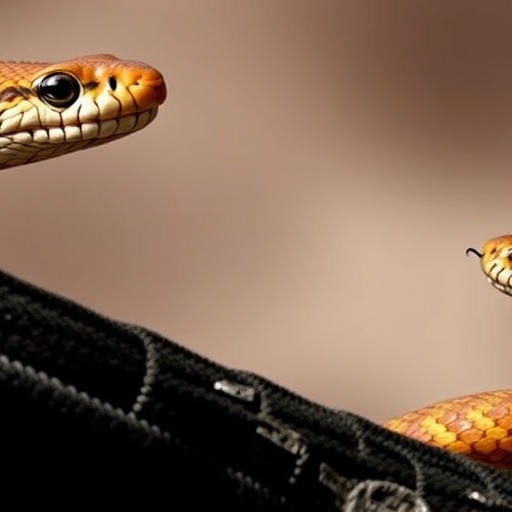In the fragmented wetlands of Michigan, a lesser-known but ecologically pivotal inhabitant faces an invisible threat: inbreeding depression. Eastern Massasauga rattlesnakes, the state’s only native rattlesnake species, are becoming increasingly isolated by an expanding human footprint. Roads, farms, and residential developments have subdivided their habitats into smaller patches, complicating their ability to find unrelated mates and threatening the genetic health of their populations. A groundbreaking 15-year study reveals troubling evidence that this isolation leads to reduced fitness and survival, underscoring an urgent need for conservation efforts grounded in genetic connectivity.
Michigan State University conservation biologists embarked on an extensive project, capturing and studying over 1,000 Eastern Massasauga rattlesnakes to unravel how spatial fragmentation influences their survival and reproduction. Employing cutting-edge genomic sequencing and long-term field monitoring, the team reconstructed detailed family trees—pedigrees—allowing them to detect the extent of inbreeding within populations. Their findings, published in the Proceedings of the National Academy of Sciences, demonstrate that snakes exhibiting higher levels of inbreeding were approximately 13% less likely to produce surviving offspring and exhibited nearly a 12% reduction in annual survival rates. These metrics illuminate the tangible consequences of genetic bottlenecking in wild populations that were previously difficult to quantify.
The Eastern Massasauga’s natural behavior compounds their vulnerability. These snakes are notoriously sedentary, often remaining within their natal wetlands for most of their lives, only venturing out briefly to seek mates in nearby habitats. Fragmentation exacerbates this tendency by erecting physical barriers and increasing mortality risks during movement attempts, thereby reinforcing isolation. Even a single road bisecting a population can dramatically hinder gene flow. This behavioral and landscape interplay effectively traps genetic material within tight lineage clusters, accelerating inbreeding and its adverse effects.
.adsslot_BzSIOn0L6j{width:728px !important;height:90px !important;}
@media(max-width:1199px){ .adsslot_BzSIOn0L6j{width:468px !important;height:60px !important;}
}
@media(max-width:767px){ .adsslot_BzSIOn0L6j{width:320px !important;height:50px !important;}
}
ADVERTISEMENT
The interdisciplinary collaboration that produced this study was remarkable. Teams from Michigan State University, Grand Valley State University, West Virginia University, and the Association of Zoos and Aquariums joined forces, alternating summers trekking through dense wetlands, armed with snake tongs and marked by resilience to inclement field conditions. Each captured snake underwent measurement, blood sampling, and PIT tagging—a microchip-like method for individual identification—before release. Such meticulous tracking enabled comprehensive longitudinal data accrual essential for robust statistical analyses.
Genomic sequencing was the linchpin in connecting blood samples to detailed pedigrees that spanned over a decade. By decoding each snake’s genetic markers, researchers quantified relatedness between individuals and charted parent-offspring relationships. Longitudinal recapture data coupled with survival tracking painted a dynamic picture of how genetic structure influences population dynamics. This synergistic approach melded laboratory science with ecological fieldwork to unveil previously hidden biological vulnerabilities.
The implications extend far beyond eastern Michigan’s wetlands. While the study focused on populations in Cass and Barry counties, many Midwestern rattlesnake groups exist in even smaller, more fragmented habitats. If inbreeding depression is already detectable in relatively larger, stable populations, it poses a predictive warning for others teetering on the brink. Species conservation paradigms must evolve to integrate genetic connectivity as a cornerstone to ensure long-term persistence, especially under accelerating anthropogenic landscape changes.
Conservation biology, historically focused on habitat preservation, now faces the challenge of facilitating gene flow across artificial barriers. Habitat restoration projects targeting wetland corridors, combined with infrastructural modifications such as road underpasses for safe wildlife crossings, represent tangible actions that could mitigate genetic isolation. Furthermore, managed relocation or translocation efforts might prove necessary for critically inbred populations, although such interventions require careful planning to maintain ecological balance and genetic diversity.
The Eastern Massasauga’s role as a keystone predator underscores the broader ecosystem significance of its survival. Controlling populations of rodents such as mice and rats, these rattlesnakes contribute to regulating species that otherwise would multiply unchecked, potentially damaging crops and spreading disease. Disruption of this delicate trophic interaction risks cascading effects throughout the wetland community, threatening biodiversity and ecosystem services vital to human welfare.
Addressing misinformation and fear surrounding rattlesnakes remains an ancillary but no less critical challenge. Public education emphasizing their ecological value and behavioral limitations can foster coexistence and support for conservation initiatives. The image of rattlesnakes as menacing or expendable pests obscures their silent contributions to environmental balance and the urgent conservation need highlighted by recent research.
The integration of genomic tools with traditional ecological monitoring signifies a transformative era in wildlife conservation, providing unprecedented resolution in understanding inbreeding impacts. By spotlighting the tangible fitness costs associated with inbreeding in wild rattlesnake populations, this research marks a critical advance towards developing scientifically informed strategies to bolster resilience in fragmented animal populations facing human-induced environmental challenges.
Subject of Research: Animals
Article Title: Inbreeding reduces fitness in spatially structured populations of a threatened rattlesnake
News Publication Date: 18-Aug-2025
Web References: http://dx.doi.org/10.1073/pnas.2501745122
Image Credits: Sarah Fitzpatrick
Keywords: Conservation genetics, Ecology
Tags: biodiversity and habitat connectivityconservation genetics researchconservation strategies for endangered speciesEastern Massasauga rattlesnakesecological significance of rattlesnakesgenetic inbreeding depressiongenomic sequencing in wildlifehabitat fragmentation effectshuman impact on reptilesMichigan wildlife conservationrattlesnake population geneticssurvival rates of rattlesnakes





